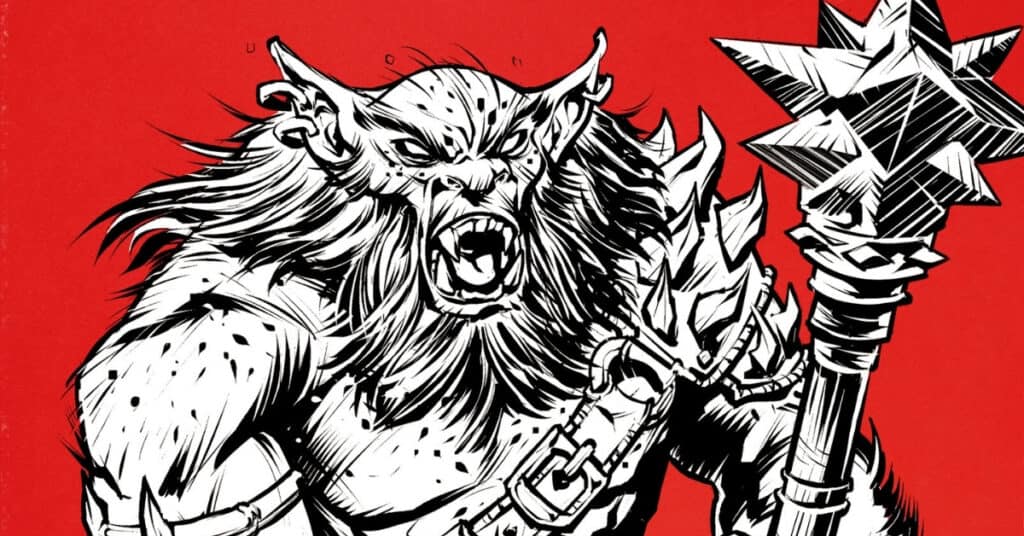Last Updated on November 1, 2023
Bugbears are 7-foot-tall, hairy, hulking monsters who rely on a mixture of brute force and cunning to defeat their opponents. Members of the goblinoid family, bugbears are often found either lording it over their weaker kin or serving as shock troops in larger goblin and hobgoblin armies.
Recently, they were introduced as a playable race. If you are looking for information on the D&D Bugbear Playable Race, check out that article instead.
Bugbears have been around as monsters in D&D for a long time. Here is the stat block for the creature version:
Bugbear
- STR 15 (+2), DEX 14 (+2), CON 13 (+1), INT 8 (-1), WIS 11 (+0), CHA 9 (-1)
- Armor Class: 16 (hide armor, shield)
- Hit Points: 27 (5d8 + 5)
- Speed: 30 ft.
- CR (XP): 1 (200 XP)
- Senses/Languages: Darkvision 60 ft., Passive Perception 10 / Common, Goblin
- Proficiency Bonus: +2
- Size: Medium
- Type: Humanoid (goblinoid)
- Alignment: Chaotic Evil
- Damage / Condition Resistance / Immunity: None
- Skills: Stealth +6, Survival +2
- Saving Throws: None
Brute. A melee weapon deals one extra die of its damage when the bugbear hits with it (included in the attack).
Surprise Attack. If the bugbear surprises a creature and hits it with an attack during the first round of combat, the target takes an extra 7 (2d6) damage from the attack.
Actions
Morningstar. Melee Weapon Attack: +4 to hit, reach 5 ft., one target. Hit: 11 (2d8 + 2) piercing damage.Javelin. Melee or Ranged Weapon Attack: +4 to hit, reach 5 ft. or range 30/120 ft., one target. Hit: 9 (2d6 + 2) piercing damage in melee or 5 (1d6 + 2) piercing damage at range.

Mechanically, bugbears get a strong +6 bonus to Stealth and get to roll an extra damage die when using a melee weapon, which makes them fearsome ambush predators.
Bugbears, despite their size and ferocity, are also remarkably stealthy — a holdover from their far-off fey origins — and capable of fitting through gaps that creatures of their size shouldn’t be able to pass through.
This ability to infiltrate, evade, and outmaneuver means that many bugbears are fond of setting ambushes and catching their enemies unawares.
Plenty of heroes have met their end after assuming bugbears are nothing more than brutes and not setting an adequate watch.
Nevertheless, bugbears also aren’t particularly brave or loyal. A captured bugbear will happily betray its own former allies if it thinks doing so will prolong its life.
Bugbear Tactics: Two Great Ways to Play Them
So, I think bugbears are a criminally misused monster in D&D 5e, and I want to rectify it.
This is almost solely down to their ability to combine brute force and strength into one massive, hairy package (we’re not still doing “phrasing,” are we?).
I think that the strength of the bugbear often ends up overshadowing their sneaky side, which in turn means they’re played wrong by DMs at different levels of the game.
Therefore, I’d like to humbly submit two ways to use bugbears to get the most out of them at different tiers of play.
Tier I: Bugbears as Sneaky Assassins
Play on the bugbear’s natural +6 to Stealth checks, not to mention their access to ranged weapons.
Make them explode out of the darkness and down a PC before disappearing again — or, better yet, drag that body away into the darkness to feed.
Or, steal all the new abilities from the playable bugbear in Monsters of the Multiverse source book.
MotM Bugbear Traits
- Fey Ancestry: Advantage on saving throws to avoid or end being charmed
- Long-Limbed: Melee attack reach increased by 5 feet.
- Powerful Build: Count as one size larger when determining carrying capacity as well as weight you can carry, drag, or lift.
- Sneaky: Proficient in Stealth and can move through a space large enough for a small creature.
- Surprise Attack: If you hit a creature before it has taken a turn in the current combat, it takes an extra 2d6 damage.
The things I’d take from this list are Long-Limbed, which should allow you to swipe out of the darkness like a true slasher villain without getting into opportunity attack range.
Sneaky. While you already have good stealth, the ability to fit through a space only large enough for a small creature is straight-up nightmare fuel.
Tier II: Bugbears in a Group of Monsters
Bugbears usually play the “brute” role in larger scale encounters — drawing attention and damage while dishing out a ton themselves.
While using bugbears this way can be highly effective, I think the real joy here is to lean back into their sneaky side. Treat them less like fuzzy ogres (that’s what ogres are for) and more like special forces.
For this, a band of goblins can make their presence known by attacking and hiding. When the party gets a bit overconfident, the bugbears can come rushing out of hiding.
Then, if you really want to dial things up to 11, throw a bugbear chief into the mix too.
- About Author
- Latest Posts
I played my first tabletop RPG (Pathfinder 1e, specifically) in college. I rocked up late to the first session with an unread rulebook and a human bard called Nick Jugger. It was a rocky start but I had a blast and now, the better part of a decade later, I play, write, and write about tabletop RPGs (mostly 5e, but also PBtA, Forged in the Dark and OSR) games for a living, which is wild.
